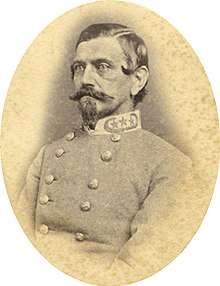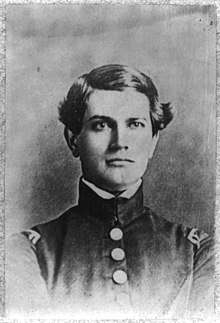James Cantey
| James Cantey | |
|---|---|
 Brig. Gen. James Cantey | |
| Born |
December 30, 1818 Camden, South Carolina |
| Died |
June 30, 1874 (aged 55) Fort Mitchell, Alabama |
| Buried | Fort Mitchell, Alabama |
| Allegiance |
|
| Service/ |
|
| Years of service |
1846–1848 (USA) 1861–1865 (CSA) |
| Rank |
|
| Unit | Palmetto Regiment (USV) |
| Commands held |
15th Alabama Infantry Regiment Cantey's Brigade |
| Battles/wars |
Mexican-American War American Civil War |
| Other work | Planter |

James Cantey (December 30, 1818 – June 30, 1874) was a Confederate States Army brigadier general during the American Civil War. He was a lawyer, planter, state legislator in South Carolina and officer in the Mexican-American War before the war and a planter in Alabama both before and after the war.
Early life
James Cantey was born on December 30, 1818 in Camden, South Carolina. After graduating from South Carolina College, where he was a member of the Euphradian Society, he studied law and practiced law in Camden. Cantey was a two-term state legislator in South Carolina. Cantey was an officer in the Palmetto Regiment in the Mexican-American War, rising to the grade of captain.[1] He was wounded during the war. After the end of the Mexican-American War, Cantey became a planter in Russell County, Alabama.[2]
Mexican-American War
Cantrey served in the Mexican-American war, in which he received wounds that were nearly fatal. He was left among the dead, but his slave servant went to retrieve his body to bury at home, but he saw faint signs of life. His servant's actions saved his life. Because of this, his servant was offered his freedom, but he refused the offer.[3]
American Civil War
James Cantey helped form and was elected colonel of the 15th Alabama Infantry Regiment in 1861, in which he organized "Cantey's Rifles". In 1862, he led the regiment in Stonewall Jackson's Valley Campaign. At the First Battle of Winchester, on May 25, 1862, Cantey's regiment fought in Brigadier General Isaac Trimble's brigade of Major General Richard S. Ewell's division and helped turn back the Union Army advance. At the Battle of Cross Keys, the 15th Alabama Infantry was nearly cut off from the main force but fought their way back. Later, as part of Trimble's attack, the 15th Regiment Alabama Infantry helped flank the Union force and drive them back.[1]
The regiment fought with Jackson in the Seven Days Battles in the Richmond, Virginia area. Thereafter, Cantey was detached[4] and sent to Mobile, Alabama from January 1863 through April 1864,[5] where he organized a brigade of three Alabama regiments and one Mississippi regiment.[1][6] Then, Cantey was transferred to the Army of Tennessee. He was appointed a brigadier general to rank from January 8, 1863. He was frequently absent from his command due to illness but also led a division for short period of time in May and June 1864.[2][5] His brigade fought in the Atlanta Campaign and Franklin–Nashville Campaign (Hood's Tennessee Campaign).[2] When present, he led the brigade with distinction, such as when his brigade held off a much larger Union force at the Battle of Resaca, Georgia.[1]
Cantey[7] and his brigade fought at General Joseph E. Johnston's last battle, the Battle of Bentonville, North Carolina.[1] Cantey's brigade surrendered with Johnston's forces at Durham Station, North Carolina. Although Longacre (1986) states that Cantey surrendered with Johnston, Eicher (2001) and Warner (1959) state that no record of Brigadier General Cantey's capture or parole has been found.[1][2][5]
Aftermath
After the Civil War, James Cantey returned to his plantation near Fort Mitchell, Alabama. He died at the plantation on June 30, 1874.[1][2] James Cantey is buried in the Crowell family cemetery at Fort Mitchell, Alabama.[2][5]
See also
Notes
- 1 2 3 4 5 6 7 Longacre, Edward G. "Cantey, James" in Historical Times Illustrated History of the Civil War, edited by Patricia L. Faust. New York: Harper & Row, 1986. ISBN 978-0-06-273116-6. p. 112
- 1 2 3 4 5 6 Warner, Ezra J. Generals in Gray: Lives of the Confederate Commanders. Baton Rouge: Louisiana State University Press, 1959. ISBN 0-8071-0823-5. p. 43
- ↑ Historcal Marker Database
- ↑ Lt. Col. William C. Oates succeeded Cantey as regimental commander and led the regiment on its famous charge up Little Round Top during the Battle of Gettysburg
- 1 2 3 4 Eicher, John H., and David J. Eicher. Civil War High Commands. Stanford, CA: Stanford University Press, 2001. ISBN 0-8047-3641-3. p. 162
- ↑ Boatner, Mark Mayo, III. The Civil War Dictionary. New York: McKay, 1988. ISBN 0-8129-1726-X. First published New York, McKay, 1959. p. 121
- ↑ Although Longacre states that Cantey was in the Carolinas Campaign, Sifakis, Stewart. Who Was Who in the Civil War. New York: Facts On File, 1988. ISBN 0-8160-1055-2. p. 104 states that Cantey does not appear to have been engaged in any major action after June 1864.
References
- Boatner, Mark Mayo, III. The Civil War Dictionary. New York: McKay, 1988. ISBN 0-8129-1726-X. First published New York, McKay, 1959.
- Eicher, John H., and David J. Eicher. Civil War High Commands. Stanford, CA: Stanford University Press, 2001. ISBN 0-8047-3641-3.
- Longacre, Edward G. "Cantey, James" in Historical Times Illustrated History of the Civil War, edited by Patricia L. Faust. New York: Harper & Row, 1986. ISBN 978-0-06-273116-6. p. 112.
- Sifakis, Stewart. Who Was Who in the Civil War. New York: Facts On File, 1988. ISBN 0-8160-1055-2.
- Warner, Ezra J. Generals in Gray: Lives of the Confederate Commanders. Baton Rouge: Louisiana State University Press, 1959. ISBN 0-8071-0823-5.